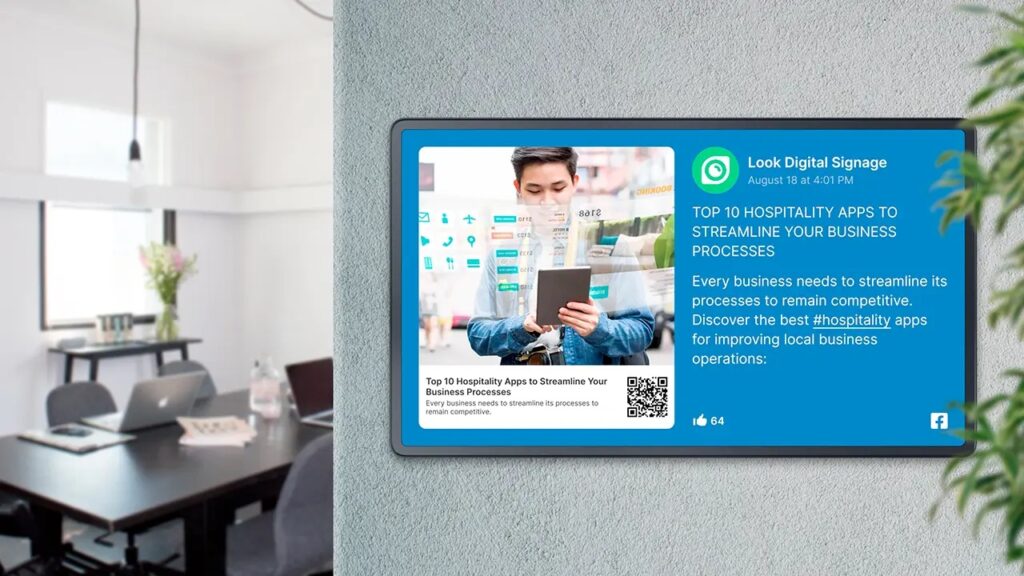18
Oct
The Ultimate Guide to Digital Signage Software: Enhancing Communication and Engagement

In today’s digital age, businesses are constantly seeking innovative ways to communicate effectively with their audiences. One of the most impactful methods is through digital signage software. Whether you’re in retail, hospitality, healthcare, or education, this technology provides an engaging platform to display dynamic content. In this guide, we’ll explore what digital signage software is, how it works, its benefits, and how to choose the best solution for your business.
What is Digital Signage Software?
Digital signage software enables businesses to display digital content—such as advertisements, announcements, menus, and interactive applications—on various screens. It works by connecting a network of displays to a centralized system that controls and manages content distribution in real-time. From a single dashboard, users can schedule content, customize layouts, and monitor display performance.
How Does Digital Signage Software Work?
A typical digital signage system consists of three main components:
- Hardware – This includes displays (LED, LCD, or video walls), media players, and the network that connects everything.
- Software – The backbone of digital signage, the software manages the content displayed on the screens. It enables users to design, schedule, and distribute content.
- Content – The videos, images, text, and applications displayed on the screens, often customized for the target audience.
The software can be either cloud-based or on-premise. Cloud-based digital signage solutions offer remote access, scalability, and easier content management, while on-premise software offers higher security and more control over data.
Benefits of Digital Signage Software
- Enhanced Communication: Digital signage displays capture attention more effectively than static signs. Whether you’re using it for in-store promotions or internal communications, dynamic content is more engaging.
- Cost-Effective: While initial setup costs may seem high, digital signage reduces the recurring expenses of printing and distributing physical materials. Content can be updated instantly without additional costs.
- Boosted Customer Engagement: In retail and hospitality, digital signage can provide personalized messages and promotions based on customer behavior, increasing sales and enhancing the shopping experience.
- Flexibility and Control: With digital signage software, businesses can easily update content in real time across multiple locations, ensuring consistency and relevance.
- Improved Brand Image: Using high-quality visuals and interactive content creates a modern and tech-savvy brand impression.
- Analytics and Insights: Many digital signage platforms come with built-in analytics to measure content performance, viewer engagement, and even foot traffic.
Industries Benefiting from Digital Signage Software
- Retail: Digital signage is used to promote products, provide real-time offers, and guide customers through the store.
- Healthcare: Hospitals and clinics use signage for wayfinding, patient education, and emergency alerts.
- Hospitality: Hotels and restaurants leverage digital displays for digital menus, event information, and promotions.
- Education: Schools and universities use digital signage to share important announcements, upcoming events, and emergency notifications.
- Corporate: Offices implement digital signage for internal communication, such as displaying KPIs, corporate news, and motivational content.
Key Features to Look for in Digital Signage Software
When selecting a digital signage solution, it’s important to consider features that align with your business needs. Here are some must-have capabilities:
- Content Scheduling: The ability to schedule content in advance ensures your displays are always showing relevant messages.
- Customizable Templates: Pre-built templates for various industries make content creation easy and professional.
- Remote Management: A cloud-based platform allows you to manage and update content from anywhere.
- Real-Time Updates: Ensure that the software supports real-time content changes, ideal for displaying up-to-date news, social media feeds, and live data.
- Interactive Capabilities: If you’re using kiosks or touchscreens, choose software that supports interactive features like maps, product information, and customer feedback.
- Data Analytics: Choose software that provides analytics and reporting tools to measure content performance and ROI.
- Multi-Location Support: If you operate in multiple locations, look for a software that allows centralized control over all your displays.
Barcodes for Business offers Digital Signage Software that enables businesses to easily create, manage, and deploy dynamic content across multiple screens, enhancing customer engagement, streamlining communication, and providing real-time updates tailored to your specific industry needs. Contact us today to learn more!
